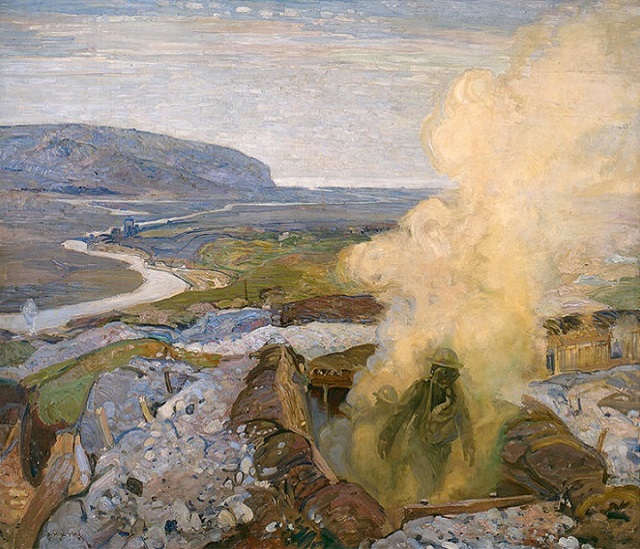The introduction of gas warfare in 1915 meant that soldiers of all sides would have to learn to survive this new weapon. The hills near Seaford played host to a training gas chamber for just this purpose.
The first serious use of gas as a weapon in the First World War came at Ypres in April 1915. The German army released clouds of deadly chlorine gas from bottles along their front which the breeze then carried into French trenches. When inhaled chlorine gas would quickly cause terrible damage to the respitory system. The British and French were quick to condemn this new weapon, as were allied nations such as America, but in September 1915 the British launched their own retaliatory gas attack at Loos.
Gas Warfare
As the war progressed, the combatants would produce gas weapons in ever increasing numbers with new variations such as phosgene, which was more deadly than chlorine and would often have a delayed reaction, and the infamous Mustard Gas which caused terrible internal and external blisters on those exposed to it. Disphosgene was developed by the German army and used against the French at Verdun as it destroyed the filters in gas masks leaving soldiers with no defence to it.
Poison gas was not a perfect weapon, however. Any change in the wind and clouds of gas could be blown back onto the attackers. Further issues came from the tendency of gas to linger in semi liquid puddles in No Man’s Land and in shell holes, making it an ongoing danger for both sides. The reliance on the breeze to convey gas to the enemy was also circumvented by the development of gas shell technology which meant that artillery batteries could fire gas directly into opposition trenches.
Protection against poison gas was of great importance to armies on both sides and lengths were taken to provide soldiers with a variety of gas masks that would allow them to survive contact with gas whilst still being able to fight if required. To provide soldiers with experience of gas, training camps were set up that required men to walk through gas filled chambers.
Following the war the use of poison gas was banned in international law in 1925. The gas shells used on the Western Front continue to hold very real dangers even to this day.

Fred Varley
Gas Chamber at Seaford
CWM 19710261-0772
Beaverbrook Collection of War Art
© Canadian War Museum
‘Gas Chamber at Seaford’
Fred Varley had been born in Sheffield in 1881 before emigrating to Canada in 1912. A keen painter he joined the Canadian Army in 1918 before his artistic skills came to be recognised. At this point he was designated an ‘official war artist’ and then travelled with Canadian soldiers recording their activities. In 1918, he painted a training session in a gas chamber at Seaford. He would continue to capture his wartime experience on canvas and many of this paintings are now famous for the scenes they portray and Varley’s increasing horror at the war.
After the war he was a founding member of the artistic ‘Group of Seven’ renowned for painting landscapes of the Canadian wilderness.
His striking image of the Gas Chamber at Seaford with the Cuckmere River in the background has been kindly provided to us by the Canadian War Museum and we thank them for it.









